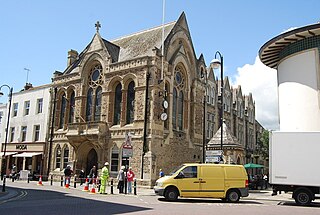
Bolton Town Hall in Victoria Square, Bolton, Greater Manchester, England, was built between 1866 and 1873 for the County Borough of Bolton to designs by William Hill of Leeds and George Woodhouse of Bolton. The town hall was extended in the 1930s to the designs of Bradshaw, Gass and Hope and has been designated a Grade II* listed building by English Heritage.

Acton Town Hall is a municipal building in High Street, Acton, London. It is a Grade II listed building.

Keighley Town Hall is an early 20th century municipal building in Keighley, West Yorkshire, England. It is a Grade II listed building.

Stockton-on-Tees Town Hall is a municipal building in the High Street in Stockton-on-Tees, County Durham, England. The building, which is the meeting place of Stockton-on-Tees Borough Council, is a Grade II* listed building.

Farnworth Town Hall is a municipal building in Market Street, Farnworth, Greater Manchester, England. The town hall, which was the headquarters of Farnworth Borough Council, is a grade II listed building.

Towcester Town Hall is a municipal building in Watling Street, Towcester, Northamptonshire, England. The town hall, which is the meeting place of Towcester Town Council, is a grade II listed building.

Calne Town Hall is a municipal building in The Strand, Calne, Wiltshire, England. The town hall, which is the meeting place of Calne Town Council, is a grade II listed building.

Hastings Town Hall is a municipal building in Queen's Road, Hastings, East Sussex, England. The town hall, which was the meeting place of Hastings Borough Council, is a Grade II listed building.

Crewe Municipal Buildings is a municipal building in Earle Street, Crewe, Cheshire, England. The buildings, which formed the headquarters of Crewe and Nantwich Borough Council, are Grade II listed.

Bridgwater Town Hall is a municipal building in the High Street, Bridgwater, Somerset, England. The town hall, which was the headquarters of Bridgwater Borough Council, is a Grade II listed building.

Godalming Borough Hall is a municipal building in Bridge Street in Godalming, England. The building is the meeting place of Godalming Town Council.

The Moot Hall is a municipal building in the High Street in Maldon, Essex, England. The building, which was the headquarters of Maldon Borough Council, is a Grade I listed building.

Brixham Town Hall is a municipal building in New Street, Brixham, Devon, England. The structure, which is the meeting place of Brixham Town Council, is a Grade II listed building.

Elland Town Hall is a municipal building in Southgate, Elland, West Yorkshire, England. The structure, which was primarily used as an events venue, is a Grade II listed building.

The Old Town Hall, sometimes referred to as the Moot Hall, is a municipal building in Church Street, Clitheroe, Lancashire, England. The structure, which was the meeting place of Clitheroe Borough Council, is a Grade II listed building.

Sandown Town Hall is a municipal building in Grafton Street, Sandown, Isle of Wight, England. The structure, which was the meeting place of Sandown Urban District Council, is a Grade II listed building.

Liskeard Guildhall is a municipal building in Pike Street, Liskeard, Cornwall, England. The structure, which was the meeting place of Liskeard Borough Council, is a Grade II* listed building.

Chipping Campden Town Hall is a municipal building in the High Street, Chipping Campden, Gloucestershire, England. The building, which is the meeting place of Chipping Campden Town Council, is a Grade II* listed building.

Cottingley Town Hall is a municipal building in Main Street in Cottingley, West Yorkshire, England. The building, which was used as a church and a community centre, is a Grade II listed building.

Coldstream Town Hall is a municipal building in the High Street, Coldstream, Scottish Borders, Scotland. The structure, which currently accommodates a library and a registration office, is a Category B listed building.
























